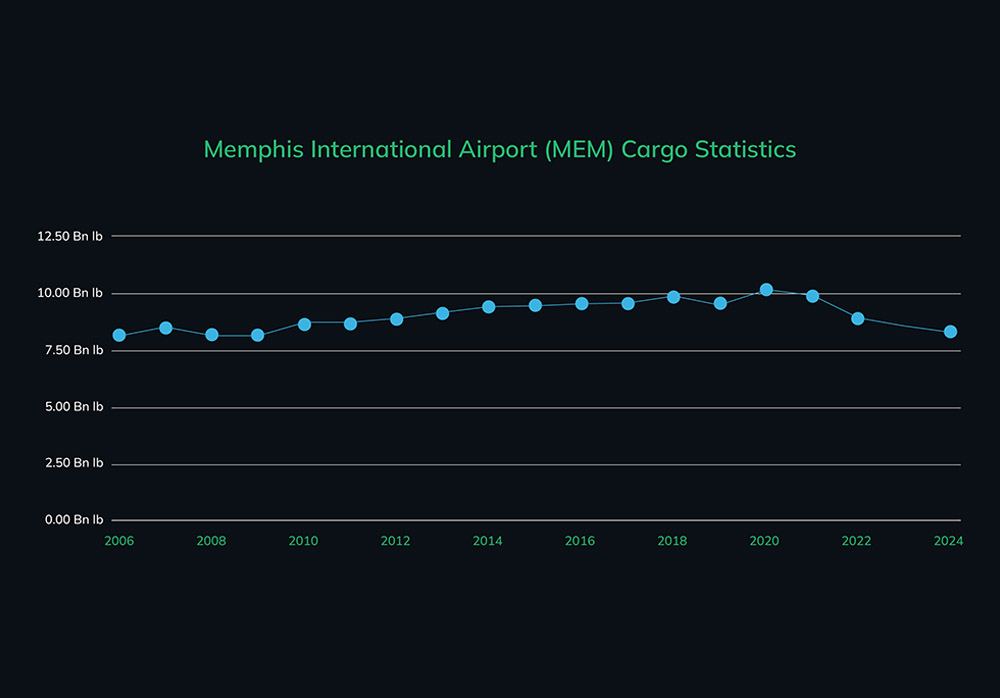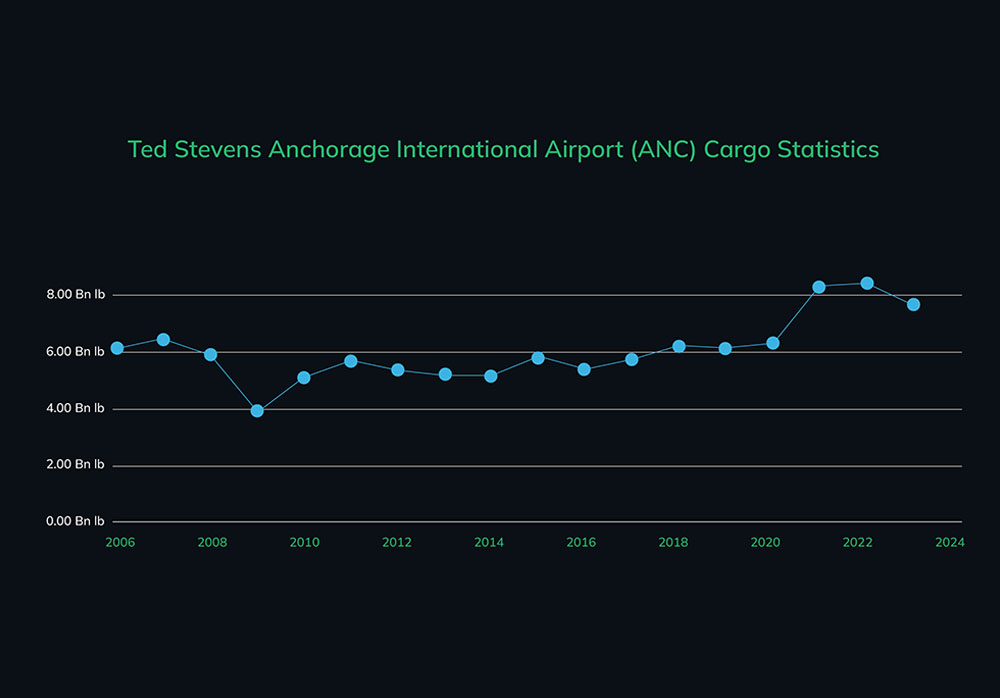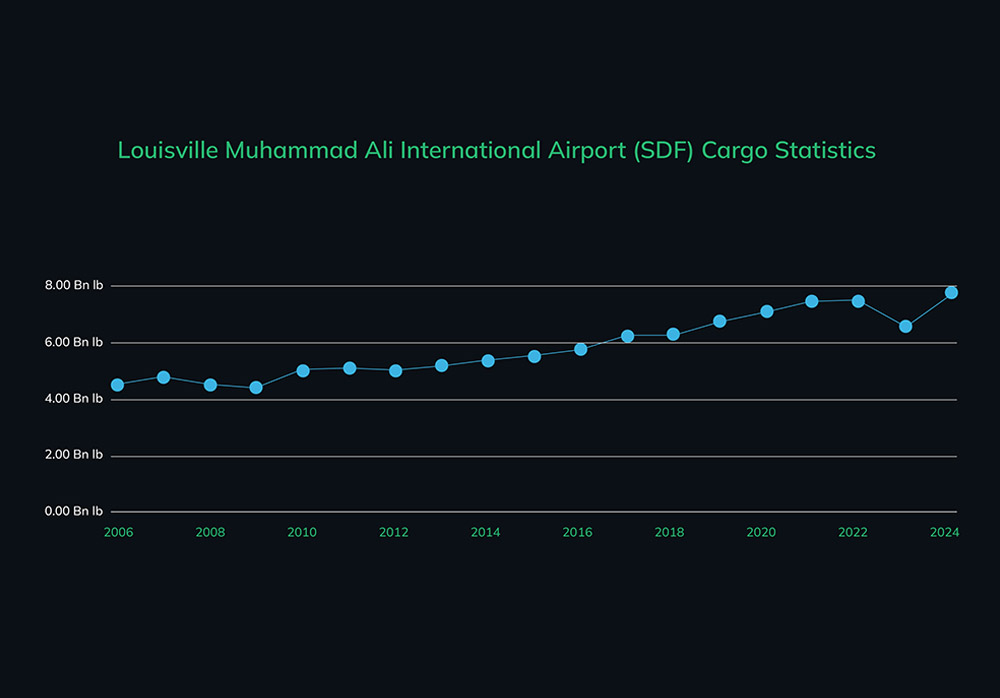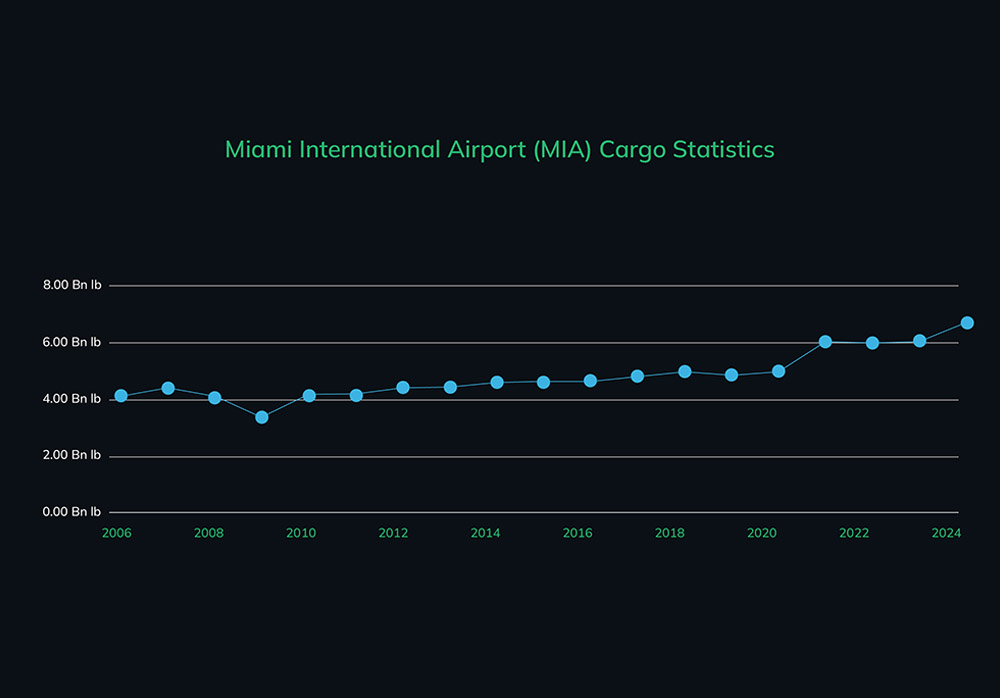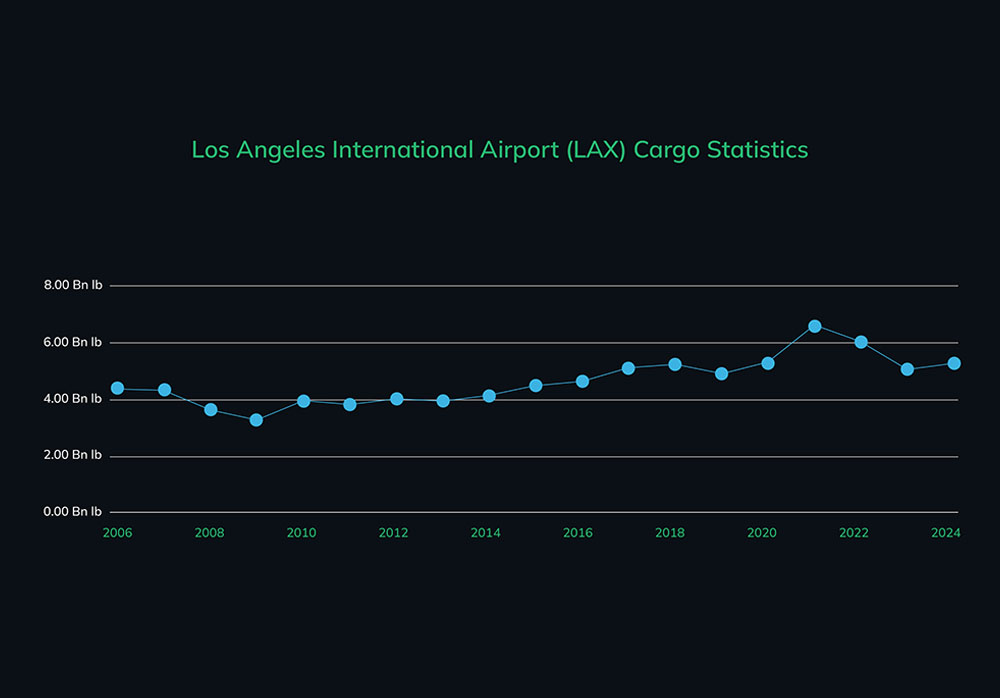Top 5 Busiest Cargo Airports In The U.S.
30 May 2025
| By Just Aviation TeamThe United States is home to some of the world’s most critical cargo hubs, driving global trade and supply chain efficiency. Leading the way are Memphis International Airport (MEM), Ted Stevens Anchorage International Airport (ANC), Louisville Muhammad Ali International Airport (SDF), Miami International Airport (MIA), and Los Angeles International Airport (LAX)—each playing a unique role in the movement of goods across continents.
From MEM’s unmatched freight volumes to ANC’s strategic Arctic crossroads, these airports form the backbone of air cargo logistics. SDF powers express shipping networks, MIA connects the Americas, and LAX dominates transpacific trade. Together, they handle millions of tons of cargo annually, supporting industries, economies, and consumers worldwide. Here’s how these aviation giants keep commerce soaring.
Memphis International Airport (IATA: MEM, ICAO: KMEM)
Memphis International Airport (MEM) is a civil-military airport located 7 mi (11 km) southeast of downtown Memphis in Shelby County, Tennessee, United States. MEM stands as one of the world’s most significant cargo hubs, renowned for its exceptional freight-handling capabilities and strategic role in global logistics. Historically, MEM consistently ranked as the busiest cargo airport globally by total cargo tonnage for nearly two decades, driven by its unparalleled infrastructure and connectivity.
While global rankings have shifted in recent years due to rising international cargo volumes, MEM remains a top-tier freight hub in the U.S., handling approximately 4.1 million metric tons of cargo annually. This volume underscores its enduring importance, supported by facilities that include expansive cargo warehouses, dedicated freight aprons, and three parallel runways—Runway 18C/36C (11,120 ft), Runway 18L/36R (9,320 ft), and Runway 18R/36L (9,000 ft)—capable of accommodating large, heavy-lift aircraft. Its central location within the U.S. further enhances efficiency, enabling rapid distribution to major cities across the country via air and ground networks.
MEM’s geographic position in the Mid-South region is a cornerstone of its logistical significance. Situated within a day’s drive of nearly 40% of the U.S. population, the airport serves as a critical nexus for domestic and international supply chains. This connectivity is vital for time-sensitive shipments, particularly in industries like healthcare, where temperature-sensitive pharmaceuticals and medical supplies require swift, reliable transport.
MEM is a powerhouse, generating billions in annual economic impact and supporting tens of thousands of jobs in the region. Its cargo operations catalyze growth across sectors, from manufacturing to retail, by ensuring efficient movement of goods. The airport’s advanced cold-chain infrastructure and expertise in handling high-value, sensitive cargo have set industry benchmarks, attracting global logistics networks. Additionally, MEM’s integration with regional trucking and rail networks creates a multimodal ecosystem, optimizing freight transit across North America.
Ted Stevens Anchorage International Airport (IATA: ANC, ICAO: PANC)
Ted Stevens Anchorage International Airport (ANC) is a pivotal hub in global air cargo logistics, leveraging its unique geographic position to serve as a critical nexus between Asia, Europe, and North America. Anchorage’s location within 9.5 hours of 90% of the industrialized world makes it an ideal refueling and transit point for long-haul freighters, enabling airlines to maximize payload efficiency by carrying more cargo instead of fuel. This strategic advantage has solidified ANC’s status as one of the world’s busiest cargo airports.
In 2022, it handled over 3.5 million metric tons of cargo, consistently ranking among the top five globally for freight throughput. The airport’s cargo operations are supported by extensive infrastructure, including dedicated freight facilities, cold storage for perishables like Alaskan seafood, and three runways—Runway 7R/25L (12,400 ft), Runway 15/33 (10,600 ft), and Runway 7L/25R (10,865 ft)—capable of accommodating large, fully loaded aircraft even in extreme weather conditions.
ANC’s role extends beyond cargo, with a growing presence in business aviation. The airport serves as a key stopover for private jets and charter flights traversing the Pacific, has services such as customs clearance, maintenance, and premium fueling. Its proximity to Anchorage’s business centers and recreational destinations—including remote wilderness areas popular with corporate retreats—enhances its appeal to high-net-worth travelers. Business aviation facilities include private hangars, dedicated terminals, and streamlined handling services, ensuring efficiency and privacy for clients.
Economically, ANC is a cornerstone of Alaska’s economy, contributing over $1 billion annually and supporting thousands of jobs. Its cargo operations are vital for e-commerce impact on cargo airlines, manufacturing, and fisheries, facilitating the rapid movement of goods between continents. The airport’s Foreign Trade Zone (FTZ) status further enhances its attractiveness by reducing tariffs and simplifying international trade processes. Meanwhile, its infrastructure investments, such as modernized cargo aprons and expanded cold-chain capabilities, ensure it remains competitive amid rising global demand for air freight.
Louisville Muhammad Ali International Airport (IATA: SDF, ICAO: KSDF)
Louisville Muhammad Ali International Airport (SDF) plays a vital role in global air cargo logistics, particularly in supporting high-speed, time-sensitive supply chains. Consistently ranking among the world’s top 10 busiest cargo airports, SDF handles approximately 2.8 million metric tons of freight each year. Its strategic location in the central United States enables swift overnight delivery to major population centers, making it a key hub for express shipping—especially in the e-commerce and healthcare sectors.
The airport features robust cargo infrastructure, including advanced sorting facilities, cold storage for perishables like pharmaceuticals, and three runways—Runway 17R/35L (12,000 ft), Runway 17L/35R (11,887 ft), and Runway 11/29 (7,250 ft)—designed to accommodate large, fully loaded freighters. Around-the-clock operations and easy access to major interstate highways enhance its efficiency, while its Foreign-Trade Zone (FTZ) status provides added logistical and cost-saving advantages for international shipments.
While cargo dominates SDF’s operations, it also supports a growing business aviation sector. The airport has dedicated facilities for private and corporate aircraft, including hangar space, maintenance services, and premium fueling. Its location near Louisville’s corporate hubs—such as healthcare, manufacturing, and logistics headquarters—makes it a convenient choice for executives and charter operators. Business travelers benefit from streamlined access to downtown Louisville, just a 10-minute drive away, as well as proximity to regional events like the Kentucky Derby, which attracts private jets annually
SDF generates billions in annual impact, supporting over 20,000 jobs in Kentucky. Its cargo operations underpin the region’s logistics-driven economy, while ongoing infrastructure investments—such as runway modernizations and expanded cargo aprons—ensure competitiveness amid rising demand. The airport’s integration with regional trucking networks and rail lines creates a multimodal gateway, accelerating freight movement across North America.
Miami International Airport (IATA: MIA, ICAO: KMIA)
Miami International Airport (MIA) stands as a key gateway for global commerce, uniquely positioned to connect North America with Latin America and the Caribbean. Known as the “Gateway to the Americas,” MIA handles over 2.3 million metric tons of cargo annually and ranks among the top U.S. airports for international freight volume. Its prominence in air trade is especially notable in the perishables sector—nearly 90% of all U.S. flower imports move through its facilities, alongside significant volumes of pharmaceuticals, electronics, and textiles.
The airport’s cargo operations are supported by specialized infrastructure such as temperature-controlled warehouses, on-site USDA inspection facilities, and a fully operational 24/7 airfield. MIA is equipped with four runways—Runway 8R/26L (10,506 ft), Runway 9/27 (13,000 ft), Runway 8L/26R (8,600 ft), and Runway 12/30 (9,354 ft)—capable of accommodating heavy freighters. Its Foreign-Trade Zone (FTZ) designation further boosts its competitiveness by having cost reductions and streamlined customs processes, solidifying its role as a dominant cargo hub in the Western Hemisphere.
MIA supports a thriving business aviation ecosystem, catering to Miami’s role as a global financial hub. Its proximity to downtown, luxury destinations, and corporate centers attracts private jets. The general aviation terminal has expedited services, including concierge handling, customs, and private lounges. Seasonal events like Art Basel boost private jet traffic, with overflow managed at nearby airports. MIA also has maintenance and fueling services, and its four runways, including two over 13,000 feet long, accommodate various aircraft types, from jets to long-haul freighters.
MIA generates over $33 billion in annual business revenue and supports more than 334,000 jobs, making it Florida’s largest economic engine. Its cargo operations sustain industries ranging from agriculture to healthcare, while its passenger and business aviation networks bolster tourism and international commerce.
Los Angeles International Airport (IATA: LAX, ICAO: KLAX)
Los Angeles International Airport (LAX) is a cornerstone of global aviation, balancing massive cargo throughput with a thriving business aviation scene. Handling over 2.5 million metric tons of cargo annually, LAX ranks among the top U.S. airports for international freight, driven by its role as the primary transpacific gateway. Its proximity to the Port of Los Angeles and major highways creates a multimodal hub for industries like tech, entertainment, and agriculture. Specialized facilities, including cold storage and 24/7 customs, streamline the flow of high-value goods like electronics, pharmaceuticals, and perishables. Foreign-Trade Zone (FTZ) advantages further bolster its appeal by lowering trade costs.
Generating $37+ billion annually and supporting 620,000+ jobs, LAX anchors Southern California’s economy.
Air Cargo Operational Comparison Across Key U.S. Hubs
This table provides a side-by-side comparison of customs, security, documentation, and perishables handling protocols at top 5 U.S. cargo airports:
| Category | MEM | ANC | SDF | MIA | LAX |
| Customs Availability | 24/7 (on-site CBP) | 24/7 (CBP pre-clearance) | 24/7 (CBP on request) | 24/7 (CBP with dedicated GA lanes) | 24/7 (CBP with GA expedited processing) |
| Cargo Acceptance Times | 24/7 | 24/7 | Limited to cargo terminal hours (e.g., 04:00–23:00) | 24/7 (pre-coordinate for GA) | 24/7 (GA: prior notice) |
| Security Requirements | TSA-approved screening; AOSSP for hazmat | TSA-regulated; CCSP for dangerous goods | TSA cargo screening; chain-of-custody protocols | TSA CCSP; agriculture x-ray for int’l inbound | TSA CCAR; CA state ag inspections |
| Key Documentation | AES filing (exports), air waybill, TSA Form 7262 (int’l), phytosanitary certs (agri) | AES, e-Manifest (Canada-bound), FAA Form 8120-7 (repairs) | AES, FDA Prior Notice (pharma), FAA Form 337 (modifications) | CITES permits (wildlife), USDA permits (plants/flowers), AES | AES, CA Dept. Food/Ag permits, FAA Form 8130-3 (parts) |
| Perishables Handling | Requires advance notice; temp-controlled storage available | Cold chain for seafood; USDA inspections on-site | Priority pharma lanes; limited cold storage (pre-coordinate) | Largest perishables hub (90% U.S. flowers); on-site USDA inspectors | Temp-controlled storage; limited capacity during peak seasons (pre-book) |
| Special Notes | Fast-track FTZ processing; minimal dwell time due to express focus | Ideal for tech stops; fuel-efficient layovers reduce payload restrictions | Express-focused; shorter dwell times but stricter cutoffs for overnight shipments | High congestion; pre-file docs for faster release; strong LatAm trade focus | Strict slot controls; delays common during rush hours; FTZ benefits apply |
These five cargo powerhouses—MEM, ANC, SDF, MIA, and LAX—drive the pulse of global logistics, ensuring seamless trade across continents. For expert flight support, cargo and baggage handling operations at these hubs and beyond, Just Aviation delivers precision and reliability, keeping your operations soaring. Trust the skies, trust Just Aviation.
